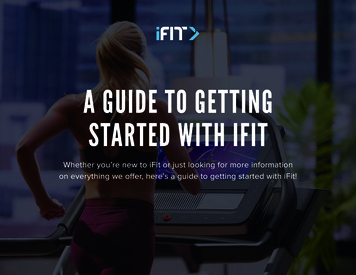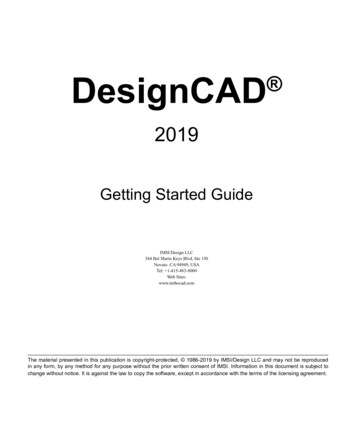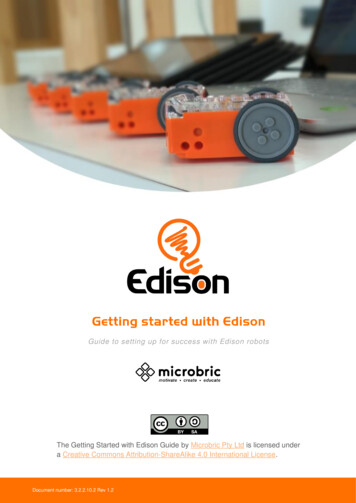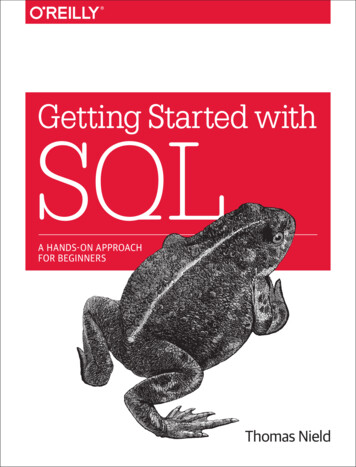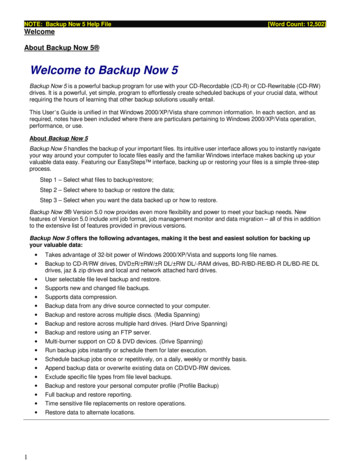
Transcription
ComplimentsofGettingStarted withOpenBTSBUILD OPEN SOURCE MOBILE NETWORKSMichael IedemaForeword by Harvind Samra
Getting Started with OpenBTSMichael Iedema
Getting Started with OpenBTSby Michael IedemaCopyright 2015 Range Networks. All rights reserved.Printed in the United States of America.Published by O’Reilly Media, Inc., 1005 Gravenstein Highway North, Sebastopol, CA 95472.O’Reilly books may be purchased for educational, business, or sales promotional use. Online editions arealso available for most titles (http://safaribooksonline.com). For more information, contact our corporate/institutional sales department: 800-998-9938 or corporate@oreilly.com.Editor: Brian MacDonaldProduction Editor: Melanie YarbroughCopyeditor: Lindsy GambleProofreader: Charles RoumeliotisJanuary 2015:Indexer: WordCo Indexing ServicesCover Designer: Karen MontgomeryInterior Designer: David FutatoIllustrator: Rebecca DemarestFirst EditionRevision History for the First Edition:2015-01-12: First releaseSee http://oreilly.com/catalog/errata.csp?isbn 9781491910658 for release details.The O’Reilly logo is a registered trademark of O’Reilly Media, Inc. Getting Started with OpenBTS, the coverimage of a Sun Conure, and related trade dress are trademarks of O’Reilly Media, Inc.Many of the designations used by manufacturers and sellers to distinguish their products are claimed astrademarks. Where those designations appear in this book, and O’Reilly Media, Inc. was aware of a trademarkclaim, the designations have been printed in caps or initial caps.While the publisher and the author have used good faith efforts to ensure that the information and instruc‐tions contained in this work are accurate, the publisher and the author disclaim all responsibility for errorsor omissions, including without limitation responsibility for damages resulting from the use of or relianceon this work. Use of the information and instructions contained in this work is at your own risk. If any codesamples or other technology this work contains or describes is subject to open source licenses or the intel‐lectual property rights of others, it is your responsibility to ensure that your use thereof complies with suchlicenses and/or rights.ISBN: 978-1-491-91065-8[LSI]
Table of ContentsForeword. . . . . . . . . . . . . . . . . . . . . . . . . . . . . . . . . . . . . . . . . . . . . . . . . . . . . . . . . . . . . . . . . . . . . viiIntroduction. . . . . . . . . . . . . . . . . . . . . . . . . . . . . . . . . . . . . . . . . . . . . . . . . . . . . . . . . . . . . . . . . . . ix1. Getting Set Up. . . . . . . . . . . . . . . . . . . . . . . . . . . . . . . . . . . . . . . . . . . . . . . . . . . . . . . . . . . . . . 1Hardware ComponentsLinux ServerSoftware Defined RadioAntennasTest PhonesTest SIMsOperating System and Development Environment SetupGit CompatibilityDownloading the CodeBuilding the CodeInstallationInstalling DependenciesInstalling ComponentsStarting/Stopping Components1123347889101011132. Initial Testing and Configuration. . . . . . . . . . . . . . . . . . . . . . . . . . . . . . . . . . . . . . . . . . . . . . 15Initial StateConfirm Radio ConnectivityEttus Research RadiosRange Networks RadiosTroubleshooting USBTroubleshooting EthernetStarting Up the NetworkThe Configuration System and CLIChanging the Band and ARFCN151515181819191920iii
Range Networks Radio CalibrationEttus Research Radio CalibrationSearching for the NetworkTesting Radio Frequency Environment FactorsReducing NoiseBoosting Handset PowerFirst ConnectionFinding the IMSIFinding the IMEIAdding a SubscriberConnectingTest SMSEcho SMS (411)Direct SMSTwo-Party SMSTest CallsTest Tone Call (2602)Echo Call (2600)Two-Party CallMeasuring Link QualityConfiguration System, ersonalizing Your NetworkShortnameRegistration 34343535353636363. Troubleshooting and Performance Tuning. . . . . . . . . . . . . . . . . . . . . . . . . . . . . . . . . . . . . . 39The stats CommandRuntime LogsLog LevelsEnvironmental TuningNonsubscriber PhonesCoverage AreaSignal DistortionStronger, Cleaner Signals39404142434446464. From Single to Multinode. . . . . . . . . . . . . . . . . . . . . . . . . . . . . . . . . . . . . . . . . . . . . . . . . . . . 49Mobility, Handover, and Roamingiv Table of Contents49
MobilityHandoverRoamingTopologyCentral Services SetupRemove OpenBTSConfigure LoggingAsterisk, SMQueue, and SIPAuthServeTower SetupConfigure SIP ProxiesConfigure LoggingTopology ReworkedAdding Neighboring TowersMust Be IdenticalMust Be UniqueNeighbor List and CommandNeighbor-Enabled CommandsCoverage Overlap Tuning4950505152525252525354545455565758585. GPRS. . . . . . . . . . . . . . . . . . . . . . . . . . . . . . . . . . . . . . . . . . . . . . . . . . . . . . . . . . . . . . . . . . . . . 61Enabling/DisablingCentral ServicesConnectingTroubleshootingPerformance TuningVoice versus GPRSIndividual Handset ThroughputCoverage Area versus ThroughputExpectations6162626364646566666. OpenRegistration. . . . . . . . . . . . . . . . . . . . . . . . . . . . . . . . . . . . . . . . . . . . . . . . . . . . . . . . . . 67EnablingPersonalizingDisabling6768697. NodeManager APIs. . . . . . . . . . . . . . . . . . . . . . . . . . . . . . . . . . . . . . . . . . . . . . . . . . . . . . . . . 71nmcli.pyVersion APIConfiguration APIRead All KeysRead One KeyUpdate717272727374Table of Contents v
PhysicalStatus API748. Onward and Upward. . . . . . . . . . . . . . . . . . . . . . . . . . . . . . . . . . . . . . . . . . . . . . . . . . . . . . . . 77Connecting to the Outside WorldVoiceSMSSpectrum RegulationSwitch Integrations3G DataOpen Source HardwareThe CommunityThe Revolution777777787878787979A. Quick Reference. . . . . . . . . . . . . . . . . . . . . . . . . . . . . . . . . . . . . . . . . . . . . . . . . . . . . . . . . . . . 81B. Operating System Installation. . . . . . . . . . . . . . . . . . . . . . . . . . . . . . . . . . . . . . . . . . . . . . . . 85C. Capturing Traffic. . . . . . . . . . . . . . . . . . . . . . . . . . . . . . . . . . . . . . . . . . . . . . . . . . . . . . . . . . . . 93Glossary. . . . . . . . . . . . . . . . . . . . . . . . . . . . . . . . . . . . . . . . . . . . . . . . . . . . . . . . . . . . . . . . . . . . . . 97Index. . . . . . . . . . . . . . . . . . . . . . . . . . . . . . . . . . . . . . . . . . . . . . . . . . . . . . . . . . . . . . . . . . . . . . . . 99vi Table of Contents
ForewordAs one of the original developers of the OpenBTS project, I’m excited to see this bookbecome a reality. It all started in our living rooms; we were not telecom people—wewere digital signal processing (DSP) software guys who had been doing GSM stuff,started playing with some early software defined radios, got introduced to VoIP, andjust wanted to see if we could build our own mobile network for less than the GDP ofa South Pacific island.Since the original source code release in 2008, it’s been astounding to see the widespreadadoption and interest in OpenBTS, which now helps provide cellular service on all sevencontinents (including several islands) and has found its way into innumerable labs anduniversities. It has really grown into a force for change in telecommunications.Typically, when I’m asked about the value or importance of OpenBTS, the discussionturns to the technical aspects of software defined radios and replacing legacy telecomprotocols with IP, etc. But why is OpenBTS—and this book, by extension—really im‐portant?Nowadays, few would argue that mobile telephony is not an essential utility—for manypeople, as indispensable as water, electricity, and gas. But the world of mobile networkinfrastructure today is a monolithic “black box.” It has de facto closed, complex systemsthat few suppliers provide, which are run on pre-Internet protocols and architecturalconcepts that have evolved in increments over 40 years to do a specific job—but noteconomically, and with little flexibility.So OpenBTS is really about empowerment. You can build a cell network. You can operatea cell network. You can learn how cell networks work. The technologies needed to builda network are no longer prohibitively expensive, nor has a handful of big organizationslocked them down.Enjoy getting started on your journey into the world of cellular networks.— Harvind Samra, Cofounder of the OpenBTS project, cofounder and CTO of RangeNetworksvii
IntroductionTelephones are cool. Yes, smartphones are cool, too, but I’m talking about plain old twowire, curly corded telephones. The ability to transmit your voice between any two pointson Earth is an amazing human accomplishment.Perhaps even more amazing is how quickly this accomplishment has been taken forgranted. Monumental efforts were undertaken over the past 100 years to build the publicswitched telephone network. Webs of copper were hung and buried. Long distance linesbetween cities and then towns were laid. Humans manually routed and connected calls,then analog machines and finally digital computers did that automatically. Along theway, mobile networks were invented and deployed. The same infrastructure story tookplace as technologies advanced: equipment was upgraded, mobile phones repeatedlyreplaced.Now, with both wired and wireless telephony networks delivering voice service solidlyfor decades, the next upgrade cycle is under way for data bandwidth: fiber optic to yourhome and LTE to your smartphone.OpenBTS bridges these two worlds. By converting between the wireless radio interfaceand open IP protocols, it allows anyone with IP connectivity to deploy a mobile network.Many places on Earth still do not have home telephone lines or mobile network recep‐tion. But, more often than not, they do have an Internet connection via satellite or longhaul WiFi. Properly integrated, OpenBTS can convert and distribute this Internet con‐nection as a mobile network across a large geographic region. Any GSM phone canconnect and use voice services or SMS, even basic data. Connectivity can be brought toremote regions while skipping the entire cycle of infrastructure build-out and upgrades.The combination of OpenBTS and software defined radios changes the way we shouldthink about mobile networks. This new technology allows the construction of complexradio networks purely in software. OpenBTS is a C application that implements theGSM stack. As new features are implemented or protocol support added, an existingOpenBTS mobile network’s capabilities can be enhanced via a simple software update!ix
Also, because OpenBTS is just software, you can make it do whatever you’d like. Youno longer need a hardware vendor’s permission to access its closed black box imple‐mentations. You can build a niche product or experimental feature; the mobile networkis finally open for innovation.Who Should Read This BookTelecom engineers—wired or wireless, circuit-switched, or packet-switched—shouldbe able to latch onto this introduction to the OpenBTS project. At the risk of spreadingthe material too thin, care has been taken to explain both the radio and IP sides ofOpenBTS. If you are a radio frequency (RF) expert, you will learn something aboutInternet telephony. If you are comfortable with SIP and RTP, you will pick up a thingor two about radio systems and protocols.Software engineers of baseband firmware, smartphone apps, or hosted services will learnabout how the mobile network itself can now be controlled and inspected at a very lowlevel. If you’re interested in debugging an application on a mobile device, OpenBTSprovides several raw interfaces to see exactly what’s going on over the air. There are alsonew data APIs your software can consume to build applications for search-and-rescue,emergency response, power optimization, roadway traffic analytics, etc.Why I Wrote This BookMy background is mainly in VoIP. When I began working with OpenBTS, I was blissfullyunaware of how complex radio systems can be. Conversely, other people I was workingwith were radio experts but had never touched VoIP. Documentation for the OpenBTSproject is plentiful but very broad to support this wide audience of interested parties; itneeded simplification.We wanted a new book that would be able to give a complete newcomer to the technologyenough information to successfully set up their own network: get voice calls working,exchange some SMS messages, etc. This initial success should then build confidenceand let that person set out on their own.I’ve tried to mix a healthy amount of context into the step-by-step sections. Mobilenetworks are still quite complex on the GSM and RF side. Every hint helps. I’m hopingyou will be able to avoid the large gotchas when setting yours up!I also wanted the book to be interesting enough to read in the absence of hardware. Thisbook should give you enough information to scope the required resources before divinginto an OpenBTS-related project.x Introduction
A Word on Mobile Networks TodayAs Marc Andreessen famously stated, “Software is eating the world.” This is definitelytrue in the mobile industry. As processing power gets faster and cheaper, it is now viableto implement extremely complex signal processing algorithms in software. This soft‐ware is also able to run on increasingly generic hardware. The days of vendor lock-indue to specialized hardware and protocols are numbered and a chance for some realcompetition and innovation in mobile infrastructure seems to be getting closer.A few years ago, a “build-your-own-mobile-network” book would have been a tome fora very different audience. The words “compile” and “customize” may not even have madean appearance. The architecture for such a network is illustrated in Figure I-1.Figure I-1. Traditional architectureThis network architecture is an incredible piece of engineering that many people ex‐amined over many years. It is very robust and scalable, though unfortunately, quiteinflexible and very expensive.There is a growing focus on this problem at universities, most notably UC Berkeley’sTechnology and Infrastructure for Emerging Regions (TIER) group and Carnegie Mel‐lon University’s CyLab Mobility Research Center in Silicon Valley, which recently pub‐lished a paper on the limitations of this traditional mobile architecture, including evo‐lutionary baggage from the traditional wired network.Introduction xi
Multiple open source projects have sprung up to address this. To name a few: Osmo‐com, OpenLTE, and YateBTS. Each project has different goals and architectures, tack‐ling the pain points of traditional networks in its own way.This book, however, is about the veteran of the group, OpenBTS. The OpenBTSproject is a collection of open source software components that can be used to build amore modern, lightweight network. OpenBTS allows the “Um” radio interface of thetraditional mobile network to directly interconnect with Internet telephony protocols.This new “hybrid” architecture is illustrated in Figure I-2.Figure I-2. Hybrid IP architectureSoftware or configuration changes on the handset are unnecessary, as the radio interfaceto the mobile network is identical to a traditional network. The network core, however,is no longer comprised of an array of complex protocols and servers. It consists of openprotocols and uses IP as its transport. Many software projects already exist that imple‐ment these open protocols. Some new components were also developed alongsideOpenBTS to provide functionality, which was still unavailable, to bridge the GSM andInternet worlds.With so much excitement around “the cloud” and so much excitement around “apps,”it seems that finally the conduit between these two is beginning to bloom.Navigating This BookBy the end of this book, you will have built a fully functional mobile network. It willappear as any other network does on your handset and route calls and SMS among theparticipants in the network, as well as provide data connectivity between handsets andthe Internet.xii Introduction
Chapter 1 guides you step-by-step through selecting radio and processing hard‐ware, setting up the base operating system and development environment, andcompiling and installing the software components. Chapter 2 covers initial component configuration and activation as well as networkfunctionality tests. Chapter 3 dives into troubleshooting and performance-tuning techniques for pro‐duction networks. Chapter 4 details how to expand your single-node network into a true multinodemobile network complete with Mobility and Handover. Chapter 5 builds on your configuration to offer general packet radio service (GPRS)data capability. Chapter 6 explores an OpenBTS-specific feature akin to WiFi captive portals, usefulfor emergency response and ad hoc networks. Chapter 7 provides reference material for interacting with and building applicationson top of the OpenBTS NodeManager control and event APIs. Chapter 8 illustrates some next steps for your network: interconnecting with thepublic switched telephone network (PSTN), private branch eXchange (PBX) inte‐grations, and the current state of spectrum regulation. Appendix A provides a quick reference for GSM terminology, RF measurements,component ports, paths, and files. Appendix B walks through the installation of the Ubuntu 12 operating system. Appendix C shows how to capture not only IP exchanges, but raw GSM radio framesas well.Online Resources OpenBTS Community OpenBTS Documentation GSM Time Slot and Channel Visualizer OpenBTS Source Code Repository on GitHubIntroduction xiii
Conventions Used in This BookThe following typographical conventions are used in this book:ItalicIndicates new terms, URLs, email addresses, filenames, and file extensions.Constant widthUsed for program listings, as well as within paragraphs to refer to program elementssuch as variable or function names, databases, data types, environment variables,statements, and keywords.Constant width boldShows commands or other text that should be typed literally by the user.Constant width italicShows text that should be replaced with user-supplied values or by values deter‐mined by context.This icon signifies a tip, suggestion, or general note.This icon indicates a warning or caution.Safari Books OnlineSafari Books Online is an on-demand digital library thatdelivers expert content in both book and video form fromthe world’s leading authors in technology and business.Technology professionals, software developers, web designers, and business and crea‐tive professionals use Safari Books Online as their primary resource for research, prob‐lem solving, learning, and certification training.Safari Books Online offers a range of product mixes and pricing programs for organi‐zations, government agencies, and individuals. Subscribers have access to thousands ofbooks, training videos, and prepublication manuscripts in one fully searchable databasefrom publishers like O’Reilly Media, Prentice Hall Professional, Addison-Wesleyxiv Introduction
Professional, Microsoft Press, Sams, Que, Peachpit Press, Focal Press, Cisco Press, JohnWiley & Sons, Syngress, Morgan Kaufmann, IBM Redbooks, Packt, Adobe Press, FTPress, Apress, Manning, New Riders, McGraw-Hill, Jones & Bartlett, Course Technol‐ogy, and dozens more. For more information about Safari Books Online, please visit usonline.How to Contact UsPlease address comments and questions concerning this book to the publisher:O’Reilly Media, Inc.1005 Gravenstein Highway NorthSebastopol, CA 95472800-998-9938 (in the United States or Canada)707-829-0515 (international or local)707-829-0104 (fax)We have a web page for this book, where we list errata, examples, and any additionalinformation. You can access this page at http://oreil.ly/1yPbnN2.To comment or ask technical questions about this book, send email tobookquestions@oreilly.com.For more information about our books, courses, conferences, and news, see our websiteat http://www.oreilly.com.Find us on Facebook: http://facebook.com/oreillyFollow us on Twitter: http://twitter.com/oreillymediaWatch us on YouTube: Harvind Samra and David Burgess brought OpenBTS to life. This book would not havebeen possible without them. A special thanks to David for inviting me to join Range. Ihaven’t stopped learning since!Thanks to the community who never fails to surprise me with possible applications forOpenBTS, and to Rangers past and present who’ve humored my questions: Tom, Pat,John, Donald, Faith, and Doug.My editor, Brian MacDonald, was very kind to this first-time author and provided greatdirection. Technical reviews from Kurtis Heimerl, Ralph Schmid, and Neel Pandeyakept the material honest. Thanks to everyone involved in that process, especially to JohnCallon for deflecting bureaucracy.Introduction xv
Manuel Kasper was the first one to introduce me to VoIP during the Free World Dialupdays. Without that push, I would have never have dove in so deep to Internet telephony.Congrats to the entire Askozia team for building such a fine company from that projectand to Diederich Wermser for believing in the concept from day one.On a more personal note: I would never have been able to study abroad nor finish myCS degree without Tom Halverson of Dakota State University and Peter Riegler of theFachhochschule Braunschweig Wolfenbüttel. Both went above and beyond their dutiesto make the exchange happen, which allowed me to start my IMS research. Thanks alsoto the Madison and Wolfenbüttel release celebration teams: Berger, Bobby, Dan, Jon,Jorj, Levi, Mitch, Phil, Seth, Steve, Dege, Markus, Milo, Raiko, Sid, and Löloff.And finally to my family: Big G, Little M, Ry, and Norus. Let’s never stop making eachother laugh.xvi Introduction
CHAPTER 1Getting Set UpIn this chapter, we will guide you through the selection of hardware, installation of abase operating system, and development environment setup, as well as actually compil‐ing and installing the components that compose the OpenBTS software suite. Severalshortcuts can be taken along the way—for example, if you would prefer to use the officialbinary packages instead of compiling your own—but the entire process is detailed forthose wishing to build from scratch.Hardware ComponentsAlthough OpenBTS implements most of the complexity involved in building a mobilenetwork in software, radio waves must still be transmitted and received somehow. Thissection details which hardware components you should procure to implement this ca‐pability in a development setting. The configuration of these components is covered inChapter 2.Linux ServerThe first requirement is a standard commodity Linux server. Other architectures arebeginning to be supported, but stick to an x86 processor running a 32-bit operatingsystem for the best results for now. This computer can be a separate machine in yourtest environment or it can actually be a virtual machine on the laptop or desktop youuse daily.Minimum requirements for processing power and RAM are not clearly defined due tothe many variables involved, such as the number of concurrent carrier signals, networkload, network usage type, radio environment, etc. Each will affect the required resources.A single carrier signal requires the OpenBTS software to generate downlink waveformsto transmit to the handset and demodulate the uplink waveforms received from the1
handset. OpenBTS supports the creation of multiple concurrent carrier signals on asingle physical radio to linearly increase network capacity, but the processing demandsare very high. For a stable lab setup with a single carrier signal (maximum of sevenconcurrent voice channels), an Intel i5 or something comparable with 2 GB of RAM isrecommended. It must also have at least a USB2 interface, but USB3 is quickly becominga requirement on newer software defined radios. It may be a good idea to start withUSB3 now to avoid a future upgrade.The need for increased throughput on the USB interface relates to the quantity and sizeof radio waveform samples being communicated through it. In a production environ‐ment, multiple simultaneous carrier signals can be utilized, which drastically increasesthe required sample bandwidth. Additionally, the algorithms used to demodulate signalscan be configured to operate in a more robust manner (e.g., to rectify signal distortiondue to the deployment environment). Thus, the processing power needed to generateand demodulate these signals could be an order of magnitude greater than in a lab setup.Another thing to keep in mind is that as newer releases of OpenBTS are made available,new capabilities may require more processing power or memory. For example,OpenBTS in Global System for Mobile (GSM) mode can run smoothly on an Intel Atomprocessor but the new OpenBTS-UMTS (Universal Mobile Telephone System) requiresat least an Intel i7. This sidenote is actually the main advantage of having a radio accessnetwork (RAN) defined in software. As new standards are released, they can be appliedto a production RAN via a simple software update instead of swapping expensive hard‐ware infrastructure.Software Defined RadioThe software defined radio (SDR) is the key breakthrough that makes OpenBTS possiblefrom a hardware perspective. SDRs have been used in military applications for about20 years. Only recently have they become available to a wider audience due to the de‐creasing cost of the technology.A modern SDR is a piece of hardware that connects to your computer via a USB cableor over Ethernet. They are typically as small as a deck of cards or as large as a stack ofthree DVDs and are powered either directly via the USB host connection or by a smallexternal power supply. The SDR hardware implements a completely generic radio thatcan send and receive raw waveforms in a defined frequency range (i.e., 60 MHz to 4GHz) with a host application. That host application could be an FM radio implemen‐tation that receives the raw waveforms, demodulates the signal, and plays back the audio.This means that radio hardware is no longer designed around a specific application; itis completely up to the host to define the implementation, allowing anyone to createradio applications purely in software.OpenBTS supports SDRs from several vendors: Ettus Research, Fairwaves, Nuand, andRange Networks. These products range in price from approximately 500 to over 2500.2 Chapter 1: Getting Set Up
If you choose a product that connects via Ethernet, make sure your Linux server has adedicated Ethernet port for the radio (preferably gigabit Ethernet).Most SDRs are completely generic hardware suitable for any radioproject while some are specifically optimized for implementing mo‐bile networks. Check with the vendor before purchasing.AntennasMany SDRs have enough transmit and receive sensitivity to operate without antennasin a small environment. Typically, a coverage area with a radius of 1 m can be achieved.This is a desirable setup for a lab environment, especially if multiple developers are usingmultiple radios. The coverage areas will not overlap and interfere with each other. Ad‐ditionally, your network will not interfere with any carriers in the area.Even if your coverage area is very small, the national regulator willstill most likely require you to obtain a test license before using GSMfrequencies. More information is in “Spectrum Regulation” on page 78.In lab environments where a single OpenBTS instance is to be shared among multipledevelopers, the coverage area must be expanded. Adding a pair of small 5 dBi antennascan increase it dramatically, up to a 25 m radius in an unobstructed environment. Theseare usually rubber duck–style antennas with a SubMiniature version A (SMA) connec‐tor, similar in appearance to a typical home WiFi router antenna. An example is shownin Figure 1-1.Antennas are tuned for a specific frequency, so choose one that most closely matchesthe GSM band you will be using (850, 900, 1800, or 1900 MHz).The frequency also plays a role in the coverage area size. Low-frequency bands (850 and900 MHz) propagate larger distances than high-frequency bands—sometimes nearlytwice as far.Test PhonesFor testing, at least two GSM handsets compatible with the band you will be using (850,900, 1800, or 1900 MHz) are needed. Most modern GSM handsets are “quad-band,”meaning that all bands are supported. There are also “tri-band” and “dual-band” hand‐sets. The easiest way to determine if a handset will be band compatible with your networkHardware Components 3
is to search for the model on GSM Arena. Complete technical specifications are listedthere.Figure 1-1. Rubber-duck antennaYou must also make sure that the handset you are using is unlocked. If the handset is“locked,” it means that the manufacturer has programmed the hardware’s basebandprocessor to only work with a specific carrier. This restriction can be removed, usuallyby entering a sequence of numbers on the dialpad, but that is beyond the scope of thisbook. The easiest choice is to use an unlocked handset that will accept any carrier’ssubscriber identity module (SIM) card.Test SIMsThe SIM used in GSM handsets is nothing more than a trimmed-down smart card.Smart cards are also known as chip cards or integrated circuit cards (ICCs) and can befound in many authentication and identification applications. A full-size smart card hasthe same dimensions as a credit card; newer credit cards actually use smart card tech‐nology to increase security. SIM cards are programmed using standard smart cardwriters and, once written, are popped out of the full-size card frame so they fit into aGSM handset. Figure 1-2 shows the full-size smart card carrier, popped out full-sizeSIM card, and trimmed-down micro SIM card.4 Chapter 1: Getting Set Up
Figure 1-2. Smart card frame, full-size SIM, and micro SIMThere are a couple of ways to procure SIMs fo
Enjoy getting started on your journey into the world of cellular networks. — Harvind Samra, Cofounder of the OpenBTS project, cofounder and CTO of Range Networks vii. Introduction Telephones are cool. Yes, smartp





